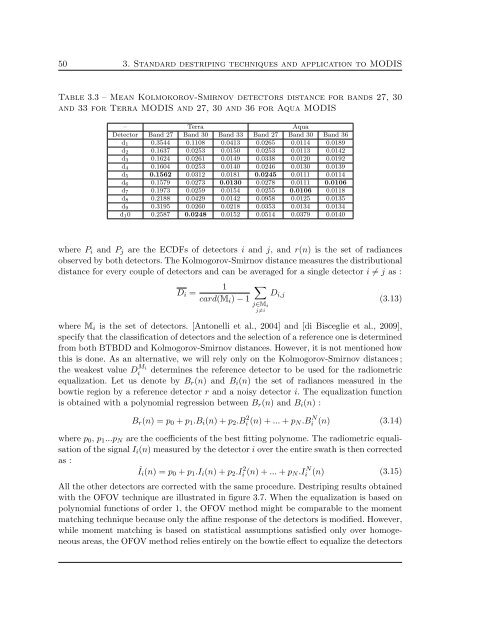Th`ese Marouan BOUALI - Sites personnels de TELECOM ParisTech
Th`ese Marouan BOUALI - Sites personnels de TELECOM ParisTech
Th`ese Marouan BOUALI - Sites personnels de TELECOM ParisTech
You also want an ePaper? Increase the reach of your titles
YUMPU automatically turns print PDFs into web optimized ePapers that Google loves.
50 3. Standard <strong>de</strong>striping techniques and application to MODIS<br />
Table 3.3 – Mean Kolmokorov-Smirnov <strong>de</strong>tectors distance for bands 27, 30<br />
and 33 for Terra MODIS and 27, 30 and 36 for Aqua MODIS<br />
– Terra Aqua<br />
Detector Band 27 Band 30 Band 33 Band 27 Band 30 Band 36<br />
d 1 0.3544 0.1108 0.0413 0.0265 0.0114 0.0189<br />
d 2 0.1637 0.0253 0.0150 0.0253 0.0113 0.0142<br />
d 3 0.1624 0.0261 0.0149 0.0338 0.0120 0.0192<br />
d 4 0.1604 0.0253 0.0140 0.0246 0.0130 0.0139<br />
d 5 0.1562 0.0312 0.0181 0.0245 0.0111 0.0114<br />
d 6 0.1579 0.0273 0.0130 0.0278 0.0111 0.0106<br />
d 7 0.1973 0.0259 0.0154 0.0255 0.0106 0.0118<br />
d 8 0.2188 0.0429 0.0142 0.0958 0.0125 0.0135<br />
d 9 0.3195 0.0260 0.0218 0.0353 0.0134 0.0134<br />
d 1 0 0.2587 0.0248 0.0152 0.0514 0.0379 0.0140<br />
where P i and P j are the ECDFs of <strong>de</strong>tectors i and j, and r(n) is the set of radiances<br />
observed by both <strong>de</strong>tectors. The Kolmogorov-Smirnov distance measures the distributional<br />
distance for every couple of <strong>de</strong>tectors and can be averaged for a single <strong>de</strong>tector i ≠ j as :<br />
D i =<br />
1<br />
card(M i ) − 1<br />
∑<br />
D i,j<br />
(3.13)<br />
where M i is the set of <strong>de</strong>tectors. [Antonelli et al., 2004] and [di Bisceglie et al., 2009],<br />
specify that the classification of <strong>de</strong>tectors and the selection of a reference one is <strong>de</strong>termined<br />
from both BTBDD and Kolmogorov-Smirnov distances. However, it is not mentioned how<br />
this is done. As an alternative, we will rely only on the Kolmogorov-Smirnov distances ;<br />
the weakest value D M i<br />
i<br />
<strong>de</strong>termines the reference <strong>de</strong>tector to be used for the radiometric<br />
equalization. Let us <strong>de</strong>note by B r (n) and B i (n) the set of radiances measured in the<br />
bowtie region by a reference <strong>de</strong>tector r and a noisy <strong>de</strong>tector i. The equalization function<br />
is obtained with a polynomial regression between B r (n) and B i (n) :<br />
j∈M i<br />
j≠i<br />
B r (n) =p 0 + p 1 .B i (n)+p 2 .B 2 i (n)+... + p N .B N i (n) (3.14)<br />
where p 0 , p 1 ...p N are the coefficients of the best fitting polynome. The radiometric equalisation<br />
of the signal I i (n) measured by the <strong>de</strong>tector i over the entire swath is then corrected<br />
as :<br />
Î i (n) =p 0 + p 1 .I i (n)+p 2 .I 2 i (n)+... + p N .I N i (n) (3.15)<br />
All the other <strong>de</strong>tectors are corrected with the same procedure. Destriping results obtained<br />
with the OFOV technique are illustrated in figure 3.7. When the equalization is based on<br />
polynomial functions of or<strong>de</strong>r 1, the OFOV method might be comparable to the moment<br />
matching technique because only the affine response of the <strong>de</strong>tectors is modified. However,<br />
while moment matching is based on statistical assumptions satisfied only over homogeneous<br />
areas, the OFOV method relies entirely on the bowtie effect to equalize the <strong>de</strong>tectors















